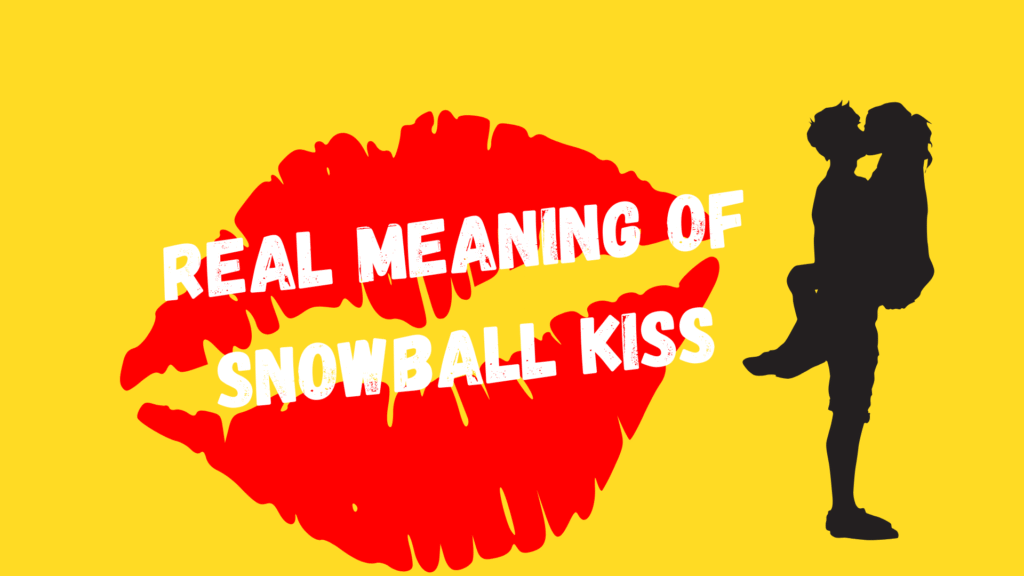When you hear “snowball kiss,” your mind might immediately conjure images of innocent winter fun or playful romantic moments in the snow. However, in the realm of modern slang, this term carries a completely different meaning that often catches people off guard. The snowball kiss meaning has evolved into adult territory, creating a stark contrast between its innocent-sounding name and its explicit definition.
Understanding sexual acts terminology has become increasingly important in our digitally connected world, where social media trends and online discussions can expose us to unfamiliar phrases. Whether you’ve encountered this term on TikTok, in raunchy comedy, or during flirty conversations, this comprehensive guide will provide you with all the information you need to understand what a snowball kiss really means.
This article serves as an educational resource for adults seeking to understand contemporary sexual terminology. We’ll explore the definition, cultural context, safety considerations, and the humor that surrounds this particular slang term, while maintaining a respectful and informative approach throughout.

What Does “Snowball Kiss” Actually Mean?
Definition and Etymology
A snowball kiss is a slang term that refers to a specific sexual act involving the transfer of semen between partners through kissing. The act typically occurs when one partner receives oral sex to completion, retains the bodily fluids in their mouth, and then shares it with their partner through a kiss. The term “snowball” is used metaphorically because of the white, fluid-like appearance and the way it’s “passed” between partners.
The snowball kiss Urban Dictionary definition has been consistent across various entries, with the term first appearing in online forums and adult communities in the early 2000s. The metaphorical connection to an actual snowball comes from both the visual similarity and the action of “passing” or “sharing” something between two people.
Key characteristics of the term:
- Visual metaphor: White, fluid-like appearance
- Action metaphor: Passing or sharing between partners
- Timing: Usually occurs immediately after oral sex
- Participants: Typically involves two consenting adults

Snowball Kiss Meaning in Simple Terms
To put it simply, a snowball kiss is when someone who has just performed oral sex on a male partner keeps the ejaculate in their mouth and then shares it with their partner through kissing. This creates a moment of intimacy that some couples find exciting, while others may find it off-putting or uncomfortable.
The term is exclusively used in adult contexts and should not be confused with innocent winter activities or romantic snow-themed kisses. Understanding this distinction is crucial for navigating conversations where the term might arise.

Variations and Related Terms
The snowball kiss belongs to a broader category of sexual terminology that includes similar acts with different names:
| Term | Description | Key Difference |
|---|---|---|
| Rainbow Kiss | Involves mixing semen with menstrual blood | Includes menstrual fluid |
| French Kiss | Deep kissing with tongue involvement | No bodily fluid exchange |
| Ice Cube Kiss | Kissing while holding ice in mouth | Involves temperature play |
| Snowballing | Same act as snowball kiss | Alternative terminology |
The snowball kiss and rainbow kiss meaning are often confused, but they represent different acts with varying levels of complexity and health risks.
Cultural Context and Usage
When & Where You Might Encounter This Term
Understanding where and when you might encounter the term “snowball kiss” helps provide context for its usage in modern culture.

In Adult Conversations and Relationships
Communication in relationships often involves discussing sexual preferences and boundaries. Partners may bring up various sexual acts during intimate conversations, and the snowball kiss might be mentioned as something they’re curious about or have heard of. These discussions typically occur in:
- Intimate partner conversations about sexual exploration
- Sexual education contexts among adults
- Adult forums and communities discussing sexual practices
- Relationship counseling sessions addressing sexual compatibility
In Comedy and Entertainment
Raunchy comedy has long been a vehicle for introducing and normalizing sexual terminology. The snowball kiss appears in:
- Stand-up comedy routines that play on the contrast between the innocent name and explicit meaning
- Adult-oriented TV shows and movies as shock humor
- Podcast discussions about sexual topics
- Comedy sketches that exploit the humor in sexual terminology
In Social Settings
Adult social media trends and party conversations often include references to sexual slang:
- Adult party conversations where playful dares might be suggested
- Drinking games with adult themes and truth-or-dare scenarios
- College dormitory discussions about sexual experiences
- Bachelor/bachelorette party conversations
Online Discussions and Social Media
The internet has become the primary breeding ground for sexual slang dissemination:
- Reddit threads in adult communities discussing sexual practices
- Urban Dictionary definitions and user submissions
- TikTok content using euphemisms and coded language
- Adult online discussions in specialized forums
Generational and Demographic Differences
Generational views on sex vary significantly when it comes to sexual terminology and practices. Younger generations, particularly those who grew up with internet access, tend to be more familiar with terms like “snowball kiss” due to their exposure to online discussions and social media trends.
Demographic breakdown:
- Gen Z (born 1997-2012): Most likely to encounter term through social media
- Millennials (born 1981-1996): Familiar through early internet forums and college culture
- Gen X (born 1965-1980): May know term through adult entertainment or partner discussions
- Baby Boomers (born 1946-1964): Least likely to be familiar with modern sexual slang
Memes, Jokes, and Internet Culture
Common Meme Formats
The snowball kiss meme phenomenon has created several recognizable formats across social media platforms:
“Don’t Google This” Warnings
- Posts warning innocent users not to search for the term
- Often accompanied by reaction images showing shock or regret
- Creates curiosity while simultaneously warning against it
Innocent vs. Reality Comparison Memes
- Side-by-side images showing what people expect vs. what it actually means
- Often features wholesome winter imagery contrasted with adult content warnings
- Popular on platforms like Instagram and Twitter
Reaction GIFs and Videos
- TikTok creators making reaction videos upon learning the meaning
- Compilation videos of people’s shocked expressions
- “Things I wish I never learned” format videos

Social Media Trends
Snowball kisses TikTok meaning has evolved into various trends and challenges:
- Coded references that allow creators to discuss the topic without explicit content
- Reaction videos showing genuine surprise when people learn the definition
- Educational content from sex educators explaining the term responsibly
- Comedy skits playing on the misunderstanding between innocent and explicit meanings
The Psychology Behind the Humor
The humor surrounding sexual slang like “snowball kiss” stems from several psychological factors:
- Incongruity Theory: The contrast between innocent expectations and explicit reality
- Superiority Theory: Those “in the know” feel superior to those who don’t understand
- Relief Theory: Laughter provides relief from sexual tension and taboo subjects
- Social Bonding: Shared knowledge of sexual slang creates in-group connections
Practical Considerations and Safety
Health and Safety Considerations
Before engaging in any sexual acts, understanding the associated health risks is crucial for making informed decisions.
Disease Transmission Risks
Risks of kissing involving bodily fluids include several serious health concerns:
Sexually Transmitted Infections (STIs):
- HIV: Risk exists if either partner has the virus
- Hepatitis B: Can be transmitted through saliva and semen
- Herpes (HSV-1 and HSV-2): Highly contagious through oral contact
- Gonorrhea and Chlamydia: Can infect mouth, throat, and genital areas
- Syphilis: Transmitted through direct contact with sores
Bacterial Infections:
- Bacterial vaginosis: Can be triggered by pH changes
- Yeast infections: May result from bacterial imbalance
- Urinary tract infections: Risk increases with certain practices
Oral Health Considerations:
- Gingivitis and periodontitis: Open sores increase transmission risk
- Thrush: Oral yeast infections can develop
- Bad breath and taste issues: Common concerns for participants
Safety Precautions
Implementing proper safety measures significantly reduces health risks:
Essential Safety Steps:
- STI testing: Both partners should have recent, clear test results
- Oral health check: Ensure no open sores, cuts, or dental issues
- Hygiene protocols: Proper cleaning before and after intimate contact
- Medical consultation: Discuss with healthcare providers if concerns exist
When to Avoid the Practice:
- During active STI outbreaks
- With open wounds in the mouth
- When either partner feels unwell
- Without proper STI testing results
Communication and Consent
Communication in relationships forms the foundation of healthy sexual experiences.
Essential Conversations
Consent must be explicit and ongoing throughout any intimate encounter:
Pre-intimacy Discussions:
- Establish clear boundaries and comfort levels
- Discuss STI status and testing history
- Address concerns about taste, texture, or hygiene
- Agree on safe words or signals to stop
During Intimacy:
- Check in regularly about comfort levels
- Respect any requests to stop or modify activities
- Maintain open communication about sensations
- Ensure both partners remain comfortable

Post-intimacy Follow-up:
- Discuss the experience openly and honestly
- Address any discomfort or concerns that arose
- Plan for future intimate encounters
- Maintain emotional closeness through communication
Relationship Dynamics
Intimacy in relationships extends beyond physical acts to include emotional connection:
Trust Building:
- Gradual introduction of new activities
- Respect for boundaries and limits
- Open communication about desires and concerns
- Consistent care for partner’s comfort and safety
Addressing Discomfort:
- Normalize discussions about sexual preferences
- Respect decisions to decline certain activities
- Explore alternative intimate acts together
- Maintain relationship connection beyond sexual activities
Practical Tips for Safety and Comfort
Preparation and Hygiene
Proper preparation enhances safety and comfort for both partners:
Personal Hygiene Protocol:
- Brush teeth and use mouthwash before intimacy
- Stay hydrated to maintain healthy saliva production
- Avoid eating strong-flavored foods before intimate contact
- Consider timing in relation to meals and oral health
Environmental Preparation:
- Choose comfortable, private settings
- Have water available for hydration
- Keep tissues or towels nearby
- Ensure good ventilation and comfortable temperature
Technique and Approach
Emotional closeness develops through careful attention to technique and comfort:
Starting Slowly:
- Begin with standard kissing to build comfort
- Gradually introduce new elements if desired
- Pay attention to partner’s body language and responses
- Allow either partner to pause or stop at any time
Communication During:
- Use non-verbal cues to gauge comfort
- Incorporate hands and other forms of touch
- Maintain eye contact when appropriate
- Keep the atmosphere relaxed and pressure-free
Aftercare and Follow-up
Post-intimacy care is crucial for maintaining emotional closeness:
Immediate Aftercare:
- Provide water for hydration and taste management
- Offer mouthwash or breath mints if desired
- Check in about comfort levels and any concerns
- Maintain physical closeness through cuddling or talking
Ongoing Communication:
- Discuss the experience within 24-48 hours
- Address any delayed concerns or questions
- Plan for future intimate encounters
- Maintain emotional connection beyond sexual activities
Social and Psychological Aspects
Why Some Find It Taboo or Off-Putting
Cultural taboos surrounding certain sexual acts stem from various social, religious, and personal factors.
Cultural and Religious Backgrounds:
- Conservative religious teachings about sexual purity
- Cultural norms that stigmatize certain sexual practices
- Generational differences in sexual openness
- Regional variations in sexual attitudes
Personal Boundaries and Preferences:
- Individual comfort levels with bodily fluids
- Past experiences that influence current preferences
- Aesthetic concerns about taste, texture, or appearance
- Personal hygiene standards and expectations
Hygiene Concerns and Misconceptions:
- Misunderstanding about actual health risks
- Exaggerated fears about cleanliness
- Lack of education about safe sexual practices
- Media portrayal influences on perception
Psychological Factors
The psychology behind sexual preferences involves complex factors:
Power Dynamics:
- Some view the act as submissive or dominant
- Partners may feel vulnerable or empowered
- Communication in relationships can address power concerns
- Healthy relationships balance power dynamics
Trust and Vulnerability:
- Intimacy requires high levels of trust
- Partners must feel safe to express preferences
- Vulnerability can strengthen or challenge relationships
- Emotional closeness develops through shared experiences
Performance Anxiety:
- Pressure to enjoy or perform certain acts
- Fear of judgment from partner
- Concerns about technique or adequacy
- Impact on overall sexual satisfaction
Societal Attitudes and Changes
Generational views on sex continue to evolve with changing social norms:
Increasing Sexual Openness:
- Younger generations more accepting of diverse sexual practices
- Social media trends normalize previously taboo subjects
- Sex education improvements lead to better understanding
- Reduced stigma around discussing sexual preferences
Impact of Pornography:
- Unrealistic expectations from adult entertainment
- Pressure to engage in acts seen in pornography
- Need for education about realistic sexual practices
- Importance of distinguishing fantasy from reality
Feminist Perspectives:
- Emphasis on consent and personal choice
- Rejection of pressure to perform certain acts
- Focus on mutual pleasure and satisfaction
- Advocacy for comprehensive sex education
Comparison with Related Terms
Similar Sexual Slang Terms
Understanding the snowball kiss in context with similar terms provides clarity:
Rainbow Kiss Comparison: The rainbow kiss involves the mixing of semen with menstrual blood, making it more complex and potentially riskier than a snowball kiss. Both terms use colorful metaphors but represent different levels of bodily fluids exchange.
French Kiss Distinction: While a French kiss involves tongue contact and saliva exchange, it doesn’t typically involve other bodily fluids. The snowball kiss is more specific and involves semen transfer.
Ice Cube Kiss Explanation: An ice cube kiss involves temperature play with ice during kissing but doesn’t necessarily involve bodily fluids beyond saliva. It’s considered less intimate than a snowball kiss.
Urban Dictionary Evolution
The snowball kiss Urban Dictionary entries have remained relatively consistent since the term’s introduction, with most definitions focusing on the semen transfer aspect. However, some variations include:
- Timing specifications (immediately after oral sex)
- Emotional context (as an expression of intimacy)
- Safety considerations (modern entries include health warnings)
- Cultural commentary (recognition of the term’s shock value)
Expert Perspectives and Research
Medical Professional Insights
Healthcare providers emphasize the importance of understanding health risks associated with sexual acts involving bodily fluids:
Dr. Sarah Mitchell, Sexual Health Specialist, states:
“Any sexual activity involving the exchange of bodily fluids carries inherent risks for STI transmission. Partners should prioritize testing, communication, and hygiene to reduce these risks significantly.”
Research Findings:
- Studies show that oral sex carries lower HIV transmission risk than vaginal or anal sex
- However, other STIs like herpes and gonorrhea transmit readily through oral contact
- Regular STI testing reduces transmission rates by up to 85% in sexually active populations
- Communication in relationships correlates with higher sexual satisfaction and safety
Relationship Counselor Perspectives
Licensed therapists emphasize the importance of consent and communication in relationships:
Key Professional Recommendations:
- Establish clear boundaries before engaging in new sexual activities
- Regular check-ins about comfort levels and preferences
- Respect for “no” without pressure or guilt
- Education about risks and safety measures
- Ongoing dialogue about sexual satisfaction and concerns
Common Counseling Themes:
- Partners feeling pressured to engage in acts they’re uncomfortable with
- Mismatched sexual preferences causing relationship strain
- Lack of communication leading to sexual dissatisfaction
- Need for education about safe sexual practices
Frequently Asked Questions
What exactly is a snowball kiss?
A snowball kiss is a slang term for a sexual act where one partner retains semen in their mouth after oral sex and then shares it with their partner through kissing. The term uses the “snowball” metaphor due to the white, fluid-like appearance and the action of passing it between partners.
How did this term originate and enter the language?
The snowball kiss meaning emerged in early internet forums and adult communities in the early 2000s. The term spread through online discussions, social media trends, and adult entertainment, eventually becoming part of mainstream sexual slang. The metaphorical connection comes from both visual similarity and the action of “sharing” between partners.
Is a snowball kiss safe to perform?
The safety of a snowball kiss depends on several factors including STI status, oral health, and proper precautions. Health risks include transmission of HIV, herpes, gonorrhea, chlamydia, and hepatitis B. Safety measures include recent STI testing, good oral hygiene, and avoiding the practice during illness or with open mouth sores.
Why do some people find snowball kissing controversial or off-putting?
Cultural taboos and personal preferences influence reactions to sexual acts. Some find it off-putting due to:
- Hygiene concerns about bodily fluids
- Religious or cultural teachings about sexual practices
- Personal boundaries and comfort levels
- Aesthetic concerns about taste or texture
- Generational views on sex that stigmatize certain acts
How common is snowball kissing among sexually active adults?
Research on specific sexual acts is limited, but surveys suggest that oral sex practices vary widely among demographics. Younger generations exposed to social media trends and online discussions report higher familiarity with terms like “snowball kiss,” though familiarity doesn’t necessarily indicate participation.
How can someone make a snowball kiss more comfortable?
Comfort improvements include:
- Communication in relationships about boundaries and preferences
- Proper hygiene including brushing teeth and using mouthwash
- Staying hydrated before and after intimate contact
- Having water available for taste management
- Starting slowly and checking comfort levels regularly
- Maintaining emotional closeness through ongoing communication
Can you get diseases from snowball kissing?
Yes, health risks include various STIs and infections. Transmission risks include:
- HIV (lower risk but possible)
- Herpes (high transmission risk)
- Gonorrhea and chlamydia (moderate to high risk)
- Hepatitis B (possible transmission)
- Bacterial infections affecting oral and genital health
How is snowball kissing different from other sexual kissing terms?
Comparison with related terms:
- Rainbow kiss: Involves menstrual blood mixed with semen
- French kiss: Deep kissing with tongue, no additional bodily fluids
- Ice cube kiss: Temperature play with ice, minimal fluid exchange
- Regular kissing: Saliva exchange only, much lower risk profile
The snowball kiss is more specific and involves higher health risks than standard kissing but is generally considered less complex than a rainbow kiss.
Key Takeaways and Final Thoughts
Understanding the snowball kiss meaning requires recognizing it as part of contemporary sexual slang that has evolved through social media trends and online discussions. While the term may initially surprise those unfamiliar with modern sexual terminology, education and open communication in relationships help navigate these topics responsibly.
Essential points to remember:
- Consent is paramount in all sexual activities
- Health risks can be minimized through proper precautions
- Communication in relationships improves both safety and satisfaction
- Personal boundaries should always be respected
- Generational views on sex continue to evolve with changing social norms
- Professional guidance is available for sexual health concerns
The contrast between the innocent-sounding name and explicit meaning has made the snowball kiss a subject of humor and social media trends, but the reality is that it represents a specific intimate act that requires careful consideration of safety, consent, and personal comfort levels.
Whether encountered in flirty conversations, raunchy comedy, or online discussions, understanding this term helps navigate modern sexual discourse with greater confidence and knowledge. Most importantly, any sexual activity should prioritize mutual consent, safety, and emotional closeness between partners.
For those curious about exploring new aspects of intimacy, remember that healthy relationships are built on trust, communication, and respect for boundaries. Professional resources including healthcare providers, relationship counselors, and certified sex educators can provide additional guidance for those seeking to enhance their sexual health and relationship satisfaction safely and responsibly.

Catherine Frank, founder of BiblicalHorizon.com, shares daily prayers and Bible verses to nurture spiritual growth. With a lifelong passion for scripture and prayer traditions, she creates accessible spiritual content that resonates with both seasoned believers and newcomers seeking divine connection.



